Pedestrians
You must give way to pedestrians on a marked pedestrian crossing:
This person is standing on a pedestrian refuge. If he steps out onto your lane you should:

When driving past parked vehicles, which of the following is it most important to do:
When driving in an area where there are many pedestrians (e.g. a bus stop) it is important to:
Which sign painted on the road tells you there is a pedestrian crossing ahead?
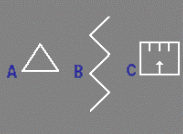
When driving near children playing or walking near the edge of the road, you should:
When you see children on or near the road:

At a pedestrian crossing with traffic lights, when the lights change to red you should
Pedestrians who are affected by alcohol, are:
At a pedestrian crossing with traffic lights, when the amber light starts 'flashing' after the red stop signal, it means:

When you see older people on or near the road, you should:
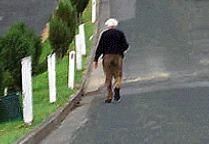
You drive up to a Light Rail vehicle that has just stopped at a tram stop. What is the most important thing you should do?

When driving in wet weather, you should:
Which statement is true?
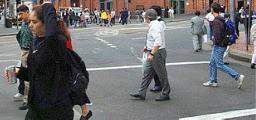
You drive up to a Light Rail vehicle that has just stopped at a tram stop. What is the most important thing you should do?

If elderly people or children are on a pedestrian crossing you will probably need to:
You approach a person crossing the road. You should:
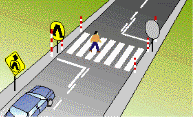
Which one of the following statements is correct? Bicycle riders:
When driving past parked vehicles, which of the following is it most important to do:
When driving near pedestrian crossings, intersections, or school crossings, you should always
When you see older people on or near the road, you should:

Which of the following statements is correct?
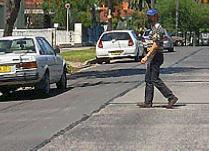
When driving in wet weather, you should:
You drive towards these people on the road. What should you do?
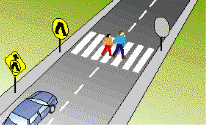
When approaching a marked pedestrian crossing and no pedestrians are in sight, you should:

If you see a School Crossing Supervisor holding a sign like this, you must wait until the children:

When driving near children playing or walking near the edge of the road, you should:
These markings on the road indicate
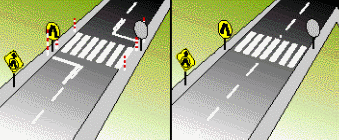
Which of the following statements is correct?

Which statement is true?

You see these zigzag markings on the road in front of you. What do they mean?

You see these zigzag markings on the road in front of you. What do they mean?

You must give way to pedestrians if there is a risk of hitting them. When driving in poor light, you should:
At a pedestrian crossing with traffic lights, when the lights change to red you should
If elderly people or children are on a pedestrian crossing you will probably need to:
You approach a crossing and see the scene in the picture. You should:

You drive towards these people on the road. What should you do?

When driving near pedestrian crossings, intersections, or school crossings, you should always
At a pedestrian crossing with traffic lights, when the amber light starts 'flashing' after the red stop signal, it means:

You must give way to pedestrians on a marked pedestrian crossing:
If you see a School Crossing Supervisor holding a sign like this, you must wait until the children:

Which one of the following statements is correct? Bicycle riders:
These markings on the road indicate

This person is standing on a pedestrian refuge. If he steps out onto your lane you should:

Pedestrians who are affected by alcohol, are:
You approach a person crossing the road. You should:

A vehicle ahead of you has stopped at a pedestrian crossing. You:

You must give way to pedestrians if there is a risk of hitting them. When driving in poor light, you should:
A vehicle ahead of you has stopped at a pedestrian crossing. You:

When you see children on or near the road:

Which sign painted on the road tells you there is a pedestrian crossing ahead?

When approaching a marked pedestrian crossing and no pedestrians are in sight, you should:

When driving in an area where there are many pedestrians (e.g. a bus stop) it is important to:
You approach a crossing and see the scene in the picture. You should:

Not enough to pass :-(
You have answered 0 correct out of 54 question(s).
What's Next?
Review your answers
See which answers you chose and what the correct answers are.
Study Guide
Review all the correct answers.
Question: {counter}
{question}
- {options}
